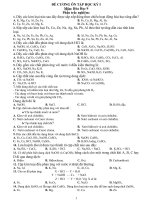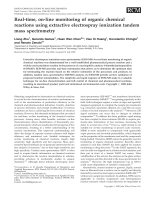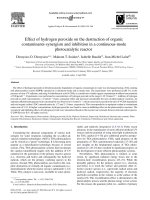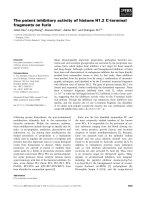Duncan c wyllie foundations on rock second Edit(BookZZ org)
Bạn đang xem bản rút gọn của tài liệu. Xem và tải ngay bản đầy đủ của tài liệu tại đây (9.53 MB, 457 trang )
Foundations on Rock
Second edition
Foundations on Rock
Duncan C.Wyllie
Principal, Golder Associates, Consulting Engineers Vancouver,
Canada
With a Foreword by Richard E.Goodman
Professor of Geological Engineering, University of California,
Berkeley, USA
Second edition
E & FN SPON
An imprint of Routledge
London and New York
First edition published 1992 by E & FN Spon, an imprint of Chapman &
Hall
Second edition published 1999 by E & FN Spon,
11 New Fetter Lane, London EC4P 4EE
Simultaneously published in the USA and Canada
by Routledge
29 West 35th Street, New York, NY 10001
E & FN Spon is an imprint of the Taylor & Francis Group
This edition published in the Taylor & Francis e-Library, 2005.
“To purchase your own copy of this or any of Taylor & Francis or Routledge’s collection of thousands of eBooks please
go to www.eBookstore.tandf.co.uk.”
© 1992, 1999 Duncan C.Wyllie
All rights reserved. No part of this book may be reprinted or reproduced or
utilised in any form or by any electronic, mechanical, or other means, now
known or hereafter invented, including photocopying and recording, or in
any information storage or retrieval system, without permission in writing
from the publishers.
The publisher makes no representation, express or implied, with regard to
the accuracy of the information contained in this book and cannot accept any
legal responsibility or liability for any errors or omissions that may be made.
The right of Duncan C.Wyllie to be identified as the author of this publication has been asserted by him in accordance with
the Copyright, Design
and Patents Act 1988.
British Library Cataloguing in Publication Data
A catalogue record for this book is available from the British Library
Library of Congress Cataloging in Publication Data
A catalogue record for this book has been requested
ISBN 0-203-47767-7 Master e-book ISBN
ISBN 0-203-78591-6 (Adobe eReader Format)
ISBN 0-419-23210-9 (Print Edition)
Contents
Foreword to first edition xiv
Introduction xv
Introduction to first edition xvii
Notation xix
Note xxi
1 Characteristics of rock foundations 1
1.1 Types of rock foundation 1
1.1.1 Spread footings 2
1.1.2 Socketed piers 3
1.1.3 Tension foundations 3
1.2 Performance of foundations on rock 4
1.2.1 Settlement and bearing capacity failures 4
1.2.2 Creep 5
1.2.3 Block failure 5
1.2.4 Failure of socketed piers and tension anchors 6
1.2.5 Influence of geological structure 7
1.2.6 Excavation methods 7
1.2.7 Reinforcement 7
1.3 Structural loads 8
1.3.1 Buildings 9
1.3.2 Bridges 10
1.3.3 Dams 11
1.3.4 Tension foundations 11
1.4 Allowable settlement 11
1.4.1 Buildings 11
1.4.2 Bridges 12
1.4.3 Dams 13
1.5 Influence of ground water on foundation performance 14
1.5.1 Foundation stability 14
1.5.2 Dams 14
1.5.3 Tension foundations 16
1.6 Factor of safety and reliability analysis 16
1.6.1 Factor of safety analysis 16
1.6.2 Limit states design 17
1.6.3 Sensitivity analysis 18
1.6.4 Coefficient of reliability 18
1.7 References 25
2 Structural geology 27
2.1 Discontinuity characteristics 27
2.1.1 Types of discontinuity 27
2.1.2 Discontinuity orientation and dimensions 29
2.2 Orientation of discontinuities 30
2.3 Stereographic projection 31
2.3.1 Pole plots 34
2.3.2 Pole density 34
2.3.3 Great circles 36
2.3.4 Stochastic modeling of discontinuities 38
2.4 Types of foundation failure 39
2.5 Kinematic analysis 39
2.5.1 Planar failure 41
2.5.2 Wedge failure 41
2.5.3 Toppling failure 41
2.5.4 Friction cone 41
2.6 Probabilistic analysis of structural geology 43
v
2.6.1 Discontinuity orientation 43
2.6.2 Discontinuity length and spacing 45
2.7 References 48
3 Rock strength and deformability 50
3.1 Range of rock strength conditions 50
3.2 Deformation modulus 52
3.2.1 Intact rock modulus 53
3.2.2 Stress-strain behavior of fractured rock 55
3.2.3 Size effects on deformation modulus 58
3.2.4 Discontinuity spacing and modulus 60
3.2.5 Modulus of anisotropic rock 61
3.2.6 Modulus-rock mass quality relationships 62
3.3 Compressive strength 64
3.3.1 Compressive strength of intact rock 66
3.3.2 Compressive strength of fractured rock 66
3.4 Shear strength 71
3.4.1 Mohr-Coulomb materials 71
3.4.2 Shear strength of discontinuities 71
3.4.3 Shear strength testing 77
3.4.4 Shear strength of fractured rock 80
3.5 Tensile strength 82
3.6 Time-dependent properties 83
3.6.1 Weathering 84
3.6.2 Swelling 86
3.6.3 Creep 87
3.6.4 Fatigue 92
3.7 References 92
4 Investigation and in situ testing methods 97
4.1 Site selection 97
4.1.1 Aerial and terrestrial photography 98
vi
4.1.2 Geophysics 100
4.2 Geological mapping 103
4.2.1 Standard geology descriptions 103
4.2.2 Discontinuity mapping 108
4.3 Drilling 110
4.3.1 Diamond drilling 110
4.3.2 Percussion drilling 115
4.3.3 Calyx drilling 116
4.4 Ground water measurements 116
4.4.1 Water pressure measurements 118
4.4.2 Permeability measurements 121
4.5 In situ modulus and shear strength testing 124
4.5.1 Modulus testing 124
4.5.2 Direct shear tests 132
4.6 References 132
5 Bearing capacity, settlement and stress distribution 138
5.1 Introduction 138
5.2 Bearing capacity 140
5.2.1 Building codes 140
5.2.2 Bearing capacity of fractured rock 141
5.2.3 Recessed footings 145
5.2.4 Bearing capacity factors 146
5.2.5 Foundations on sloping ground 147
5.2.6 Bearing capacity of shallow dipping bedded formations 147
5.2.7 Bearing capacity of layered formations 152
5.3 Bearing capacity of karstic formations 153
5.3.1 Characteristics of solution features 154
5.3.2 Detection of solution features 155
5.3.3 Foundation types in karstic terrain 157
5.4 Settlement 163
vii
5.4.1 Settlement on elastic rock 164
5.4.2 Settlement on transversely isotropic rock 169
5.4.3 Settlement on inelastic rock 173
5.4.4 Settlement due to ground subsidence 174
5.5 Stress distributions in foundations 175
5.5.1 Stress distributions in isotropic rock 175
5.5.2 Stress distributions in layered formations 179
5.5.3 Stress distributions in transversely isotropic rock 180
5.5.4 Stress distributions in eccentrically loaded footings 182
5.6 References 185
6 Stability of foundations 189
6.1 Introduction 189
6.2 Stability of sliding blocks 189
6.2.1 Deterministic stability analysis 191
6.2.2 Probabilistic stability analysis 195
6.3 Stability of wedge blocks 196
6.4 Three-dimensional stability analysis 201
6.5 Stability of toppling blocks 202
6.6 Stability of fractured rock masses 206
6.7 External effects on stability 209
6.7.1 Seismic design 209
6.7.2 Scour 210
6.8 References 213
7 Foundations of gravity and embankment dams 215
7.1 Introduction 215
7.1.1 Dam performance statistics 216
7.1.2 Foundation design for gravity and embankment dams 217
7.1.3 Loads on dams 218
7.1.4 Loading combinations 219
7.2 Sliding stability 220
viii
7.2.1 Geological conditions causing sliding 220
7.2.2 Shear strength 221
7.2.3 Water pressure distributions 221
7.2.4 Stability analysis 223
7.2.5 Factor of safety 227
7.2.6 Examples of stabilization 227
7.3 Overturning and stress distributions in foundations 228
7.3.1 Overturning 230
7.3.2 Stress and strain in foundations 230
7.4 Earthquake response of dams 235
7.4.1 Introduction 235
7.4.2 Measured motions of foundation rock 236
7.4.3 Sliding stability and overturning under seismic loads 237
7.4.4 Finite element analysis 238
7.4.5 Earthquake displacement analysis 239
7.5 Preparation of rock surfaces 243
7.5.1 Shaping 244
7.5.2 Cleaning and sealing 245
7.5.3 Rebound 246
7.5.4 Solution cavities 246
7.6 Foundation rehabilitation 247
7.6.1 Monitoring 248
7.6.2 Grouting, sealing and drainage 248
7.6.3 Anchoring 249
7.6.4 Scour protection 249
7.7 Grouting and drainage 250
7.7.1 Grouting functions 252
7.7.2 Grout types 252
7.7.3 Mechanism of grouting 253
7.7.4 Drilling method 254
ix
7.7.5 Hole patterns 255
7.7.6 Grout mixes 256
7.7.7 Grout strength 257
7.7.8 Grout pressures 257
7.7.9 Grouting procedures 259
7.7.10 Permeability criteria for grouted rock 259
7.7.11 Monitoring grouting operations 261
7.7.12 Leaching 261
7.7.13 Drainage 263
7.8 References 263
8 Rock socketed piers 269
8.1 Introduction 269
8.1.1 Types of deep foundations 269
8.1.2 Investigations for socketed piers 269
8.2 Load capacity of socketed piers in compression 271
8.2.1 Mechanism of load transfer 272
8.2.2 Shear behavior of rock sockets 272
8.2.3 Factors affecting the load capacity of socketed piers 274
8.2.4 Socketed piers in karstic formation 283
8.3 Design values: side-wall resistance and end bearing 283
8.3.1 Side-wall shear resistance 283
8.3.2 End-bearing capacity 285
8.4 Axial deformation 286
8.4.1 Settlement mechanism of socketed piers 286
8.4.2 Settlement of side-wall resistance sockets 287
8.4.3 Settlement of end loaded piers 288
8.4.4 Settlement of socketed, end bearing piers 289
8.4.5 Socketed piers with pre-load applied at base 294
8.5 Uplift 294
8.5.1 Uplift resistance in side-wall shear 295
x
8.5.2 Uplift resistance of belled piers 296
8.6 Laterally loaded socketed piers 297
8.6.1 Computing lateral deflection with p-y curves 297
8.6.2 p-y curves for rock 300
8.6.3 Socket stability under lateral load 303
8.7 References 304
9 Tension foundations 310
9.1 Introduction 310
9.2 Anchor materials and anchorage methods 311
9.2.1 Allowable working loads and safety factors 311
9.2.2 Steel relaxation 314
9.2.3 Strength properties of steel bar and strand 315
9.2.4 Applications of rigid bar anchors 315
9.2.5 Applications of strand anchors 317
9.2.6 Cement grout anchorage 318
9.2.7 Resin grout anchorage 324
9.2.8 Mechanical anchorage 326
9.3 Design procedure for tensioned anchors 326
9.3.1 Mechanics of load transfer mechanism between anchor, grout and rock 326
9.3.2 Allowable bond stresses and anchor design 329
9.3.3 Prestressed and passive anchors 332
9.3.4 Uplift capacity on rock anchors 333
9.3.5 Group action 342
9.3.6 Cyclic loading of anchors 342
9.3.7 Time-dependent behavior and creep 342
9.3.8 Effect of blasting on anchorage 344
9.3.9 Anchors in permafrost 345
9.4 Corrosion protection 345
9.4.1 Mechanism of corrosion 346
9.4.2 Types of corrosion 347
xi
9.4.3 Corrosive conditions 349
9.4.4 Corrosion protection methods 350
9.4.5 Corrosion monitoring 352
9.5 Installation and testing 353
9.5.1 Water testing 353
9.5.2 Load testing 354
9.5.3 Acceptance criteria 356
9.6 References 357
10 Construction methods in rock 360
10.1 Introduction 360
10.2 Drilling 360
10.2.1 Diamond drilling 362
10.2.2 Percussion drilling 363
10.2.3 Rotary drills 365
10.2.4 Overburden drilling 367
10.2.5 Large diameter drilling 368
10.2.6 Directional drilling 370
10.3 Blasting and non-explosive rock excavation 373
10.3.1 Rock fracture by explosives 374
10.3.2 Controlled blasting 376
10.3.3 Blasting horizontal surfaces 378
10.3.4 Ground vibration control 379
10.3.5 Vibrations in uncured concrete 383
10.3.6 Non-explosive excavation 384
10.4 Bearing surface improvement and rock reinforcement 386
10.4.1 Trim blasting 386
10.4.2 Surface preparation 386
10.4.3 Dental concrete 388
10.4.4 Shotcrete 388
10.4.5 Shear keys 390
xii
10.4.6 Rock bolts 391
10.4.7 Tensioned rock anchors 391
10.4.8 Concrete buttress 391
10.4.9 Drain holes 391
10.5 Contracts and specifications 392
10.5.1 Components of contract documents 392
10.5.2 Types of contract 393
10.5.3 Rock excavation and reinforcement specifications 394
10.6 References 398
Appen
dix I
Stereonets for handplotting of structural geology data 401
Appen
dix II
Quantitative description of discontinuities in rock masses 405
Appen
dix III
Conversion factors 422
Index 425
xiii
Foreword to first edition
Duncan Wyllie has given us a complete, useful textbook on rock foundations. It is complete in its coverage
of all parts of this important subject and in providing reference material for follow-up study. It is eminently
useful in being well organized, clearly presented, and logical.
Rock would seem to be the ultimate excellent reaction for engineering loads, and often it is. But the term
‘rock’ includes a variety of types and conditions of material, some of which are surely not ‘excellent’ and
some that are potentially dangerous. Examples of frequently hazardous rock masses are those that contain
dissolved limestones, undermined coal-bearing sediments, decomposed granites, swelling shales and highly
jointed or faulted schists or slates. Moreover, the experience record of construction in rocks includes
numerous examples of economic difficulties revolving around mistaken or apparently malevloent behavior
of rock foundations. Such cases have involved excavation overbreak, deterioration of prepared surfaces,
flooding or icing by ground water seepage, accumulation of boulders from excavation, gullying or piping of
erodible banks, and misclassification or misidentification of materials in the weathered zone. Another class
of difficult problems involve the forensic side of siting in evaluating potentialities for rock slides, fault
movement, or long-term behavior.
Problems of investigating and characterizing rock foundations are intellectually challenging; and it may
require imagination to tailor the design of a foundation to the particular morphological, structural and
material properties of a given rock site. Thus the field of engineering activity encompassed in this book is
interesting and demanding. The subject is worthy of a book on this subject and of your time in studying it.
Richard E.Goodman
Berkeley, California
Introduction
The first edition of Foundations on Rock was written during the period 1988 to 1990. In the decade that has
passed since the initial material was collected on this subject, there has been steady development in the field
of rock engineering applied to foundations, but no new techniques that have significantly changed design
and construction practices. Consequently, the purpose of preparing this second edition, which has been
written between 1996 and 1998, has been to update the technical material, and add information on new
projects where valuable experience on rock foundations has been documented.
The following is a summary of the material that has been added:
• Chapter 1: expanded discussion on acceptable reliability levels for different types of structures in relation
to the consequences of failure, as well as methods of risk analysis;
• Chapter 2: new material has been added on typical probability distributions for discontinuity lengths and
spacing, and methods of collecting data on these features;
• Chapter 3: information is included on the deformation behavior of very weak rock that has been
determined from in situ testing;
• Chapter 4: the procedures for mapping geological structure has been extensively revised to conform to the
procedures drawn up by the International Society of Rock Mechanics, and has now been consolidated in
Appendix II. It is intended that this information will help in the production of standard mapping results
that are comparable from project to project;
• Chapter 5: a list of projects with substantial foundations bearing on rock has been included describing the
rock conditions and the actual bearing pressures that have been successfully used. Also, the section on
the detection of karstic features and the design of foundations in this geological environment has been
greatly expanded. With respect to prediction of foundation performance, an example of numeric analysis
of the stability of jointed rock masses has been included;
• Chapter 6: an example has been prepared of probabilistic stability analysis to calculate the coefficient of
reliability of a foundation. Also, a technique for assessing scour potential of rock is presented in detail;
• Chapter 7: with the increasing need to rehabilitate existing dams either to meet new design standards, or
to repair deterioration, a section on foundation improvement, scour potential and tie-down anchors has
been added;
• Chapter 8: for the design of laterally loaded rock socketed piers, new information is provided on p-y
curves for very weak rock;
• Chapter 9: the testing procedures and acceptance criteria for tensioned anchors has been updated to
conform with 1990’s recommended practice;
• Chapter 10: new information has been added on contracting procedures, and in particular Partnering.
It is believed that this is still one of the few books devoted entirely to the subject of rock foundations. As
with the first edition, it is still intended to be a book that can be used by practitioners in a wide range of
geological conditions, while still providing a sound theoretical basis for design.
The preparation of this edition has drawn extensively on the knowledge of many of the author’s colleges
in both the design and construction fields, all or which are gratefully acknowledged. In addition, Glenda
Gurtina has provided great assistance in the preparation of the manuscript and Sonia Skermer has prepared
all the new artwork to her usual high standard. Finally, I would like to thank my family for supporting me
through yet another book project.
Duncan Wyllie
Vancouver, 1998
xvi
Introduction to first edition
Foundations on Rock has been written to fill an apparent gap in the geotechnical engineering literature.
Although there is wide experience and expertise in the design and construction of rock foundations, this has
not, to date, been collected in one volume. A possible reason for the absence of a book on rock foundations
is that the design and construction of soil foundations is usually more challenging than that of rock
foundations. Consequentially, there is a vast collection of literature on soil foundations, and a tendency to
assume that any structure founded on ‘bedrock’ will be totally safe against settlement and instability.
Unfortunately, rock has a habit of containing nasty surprises in the form of geological features such as
solution cavities, variable depths of weathering, and clay-filled faults. All of these features, and many
others, can result in catastrophic failure of foundations located on what appear to be sound rock surfaces.
The main purpose of this book is to assist the reader in the identification of potentially unstable rock
foundations, to demonstrate design methods appropriate for a wide range of geological conditions and
foundation types, and to describe rock construction methods. The book is divided into three main section.
Chapters 1–4 describe the investigation and measurement of the primary factors that influence the
performances of rock foundations. Namely, rock strength and modulus, fracture characteristics and
orientation, and ground water conditions. Chapters 5–9 provide details of design procedures for spread
footings, dam foundations, rock socketed piers, and tension foundations. These chapters contain worked
examples illustrating the practical application of the design methods. The third section, Chapter 10,
describes a variety of excavation and stabilization methods that are applicable to the construction of rock
foundations.
The anticipated audience for this book, which has been written by a practising rock mechanics engineer,
is the design professional in the field of geotechnical engineering. The practical examples illustrate the
design methods, and descriptions are provided of investigation methods that are used widely in the
geotechnical engineering community. It is also intended that the book will be used by graduate geotechnical
engineers as a supplement to the books currently available on rock slope engineering, geological
engineering and rock mechanics. Foundations on Rock describes techniques that are common to a wide
selection of projects involving excavations in rock and these techniques have been adapted and modified,
where appropriate, to rock foundation engineering.
Much of the material contained in this book has been acquired from the author’s experience on projects in
a wide range of geological and construction environments. On all these projects there have, of course, been
many other persons involved: colleagues, owners, contractors and, equally importantly, the construction
workers. The author acknowledges the valuable advice and experience that have been acquired from them
all.
There are many people who have made specific contributions to this book and their assistance is greatly
appreciated. Sections of the book were reviewed by Herb Hawson, Graham Rawlings, Hugh Armitage, Vic
Milligan, Dennis Moore, Larry Cornish, Norm Norrish and Upul Atukorala. In additon a number of people
contributed photographs and computer plots and they are acknowledged in the text. Important contributions
were also made by Ron Dick who produced all the drawings, and Glenys Sykes who diligently searched out
innumerable references. Finally, I appreciate the support of my family who tolerated, barely, the endless
early-morning and late-night sessions that were involved in preparing this book.
D.C.Wyllie
xviii
Notation
The following symbols are used in this book.
A Cross-sectional area (m
2
, inch
2
)
B Width of footing, diameter of pier,
burden (blasting) (m, ft)
b Radius of footing (m, ft)
C
d
Dispersion coefficient (structural
geology); influence factor for foundation
displacement
C
f
Correction factor for foundation shape
CR Coefficient of reliability
c Cohesion (MPa, p.s.i.)
D Diameter, depth of embedment (m, ft)
d Diameter (m, ft)
Mean value of displacing force (MN, lbf)
E
m
Deformation modulus of rock mass
(MPa, p.s.i.)
E
r
Deformation modulus of intact rock
(MPa, p.s.i.)
E
m(b)
Deformation modulus of rock mass in
base of pier (MPa, p.s.i.)
E
m(s)
Deformation modulus of rock mass in
shaft of pier (MPa, p.s.i.)
e Eccentricity in foundation bearing
pressure
FS Factor of safety
F Foundation factor (seismic design); shape
factor (falling head tests)
f
r
Resisting force (MN, lbf)
f
d
Displacing force (MN, lbf); factor in
limit states design
G
r, m
Shear modulus: intact rock (r), rock mass
(m) (MPa, p.s.i.)
G
1, 2
Viscoelastic constants defining creep
characteristics of rock (MPa, p.s.i.)
H Height (m, ft); horizontal component of
force(s) (MN, lbf)
h Head measurement in falling head test (m)
I Importance factor in seismic design
I
s
Point load strength (MPa, p.s.i.)
i
h
Pressure gradient
K Bulk modulus (MPa, p.s.i.)
K
s
Factor for construction type in seismic
design
k Permeability (m/s); blast vibration
attentuation factor
k
n, s
Stiffness, normal and shear (GPa/m,
p.s.i./in)
L, l Length of foundation, outcrop, socket
(m, ft)
l, m, n Unit vectors of direction cosines
(structural geology)
m Rock mass strength factor (Hoek-Brown
strength)
N Normal force (MN, lbf); number (of
analyses) bearing capacity factor
P Probability; rate of energy dissipation
(kW/m
2
)
p Pressure (MPa, p.s.i.)
PF Probability of failure
Q Foundation load (MN, lbf)
Q
s
Seepage rate (l/s, ft
3
/s)
q Flow rate (l/s, gal/s); foundation bearing
pressure (MPa, p.s.i.)
q
a
Allowable foundation bearing pressure
(MPa, p.s.i.)
R Force modification factor in seismic design
Resultant unit vector
R
e
Reynolds number
r Radius (m, ft)
S Spacing (m, ft); shear force (MN, lbf);
seismic response factor
S Siemen (unit of conductivity)
SD Standard deviation
s Rock mass strength factor (Hoek-Brown
strength)
T Basic time lag (s); rock bolt tension (MN,
lbf)
U Water uplift force (MN, lbf)
u Water uplift pressure (MPa, p.s.i.)
V Water force in tension crack (MN, lbf);
vertical component of force(s) (MN, lbf);
base shear
v Zonal velocity ratio in seismic design
W Weight of sliding block; weight factor in
seismic design
Mean value
Z Factor for seismic intensity
a Dip direction of plane, or trend of force
(degrees); adhesion factor of pier side-
walls
ß Settlement angular distortion, dip
(degrees); blast vibration attenuation factor
? Unit weight (kN/m
3
, lbf/ft
3
)
?
w
Unit weight of water (kN/m
3
, lbf/ft
3
)
d Settlement; displacement (mm, in)
? Settlement relative deflection;
displacement (mm, in)
e Strain (%)
? Dynamic viscosity—rock creep (MPa
min., p.s.i. min., poise (cgs units))
? Apex angle of rock cone (degrees)
v Poisson’s ratio
s Normal stress (MPa, p.s.i.)
s
u(m)
Uniaxial compressive strength of rock
mass (MPa, p.s.i.)
s
u(r)
Uniaxial compressive strength of intact
rock (MPa, p.s.i.)
t Shear stress (MPa, p.s.i.)
ø Friction angle (degrees)
? Dip of plane or force (degrees)
? Settlement tilt (degrees)
? Factor in rock anchor bond strength
calculation
Water table
xx
Note
The recommendations and procedures contained herein are intended as a general guide and prior to their use
in connection with any design, report or specification they should be reviewed with regard to the full
circumstances of such use. Accordingly, although every care has taken in the preparation of this book, no
liability for negligence or otherwise can be accepted by the author or the publisher.
1
Characteristics of rock foundations
1.1
Types of rock foundation
There are two distinguishing features of foundations
on rock. First, the ability of the rock to withstand
much higher loads than soil, and second, the
presence of defects in the rock which result in the
strength of the rock mass being considerably less
than that of the intact rock. The compressive
strength of rock may range from less than 5 MPa
(725 p.s.i.) to more than 200 MPa (30 000 p.s.i.),
and where the rock is strong, substantial loads can be
supported on small spread footings. However, a
single, low strength discontinuity oriented in a
particular direction may cause sliding failure of the
entire foundation.
The ability of rock to sustain significant shear and
tensile loads means that there are many types of
structures that can be constructed more readily on
rock than they can be on soil. Examples of such
structures are dams and arch bridges which produce
inclined loads in the foundation, the anchorages for
suspension bridges and other tie-down anchors
which develop uplift forces, and rock socketed piers
which support substantial loads in both compressive
and uplift. Some of these loading conditions are
illustrated in Fig. 1.1 which shows the abutment of
an arch bridge. The load on the footing for the arch
is inclined along the tangent to the arch, while the
loads on the column and abutment are vertical; the
load capacity of these footings depends primarily on
the strength and deformability of the rock mass. The
wall supporting the cut below the abutment is
anchored with tensioned and grouted rock bolts; the
load capacity of these bolts depends upon the shear
strength developed at rock-grout interface in the
anchorage zone.
If the material forming the foundations of the bridge
shown in Fig. 1.1 was all strong, massive,
homogeneous rock with properties similar to
concrete, design and construction of the footings
would be a trivial matter because the loads applied
by a structure are generally much less than the rock
strength. However, rock almost always contains
discontinuities that can range from joints with rough
surfaces and cohesive infillings that have significant
shear strength, to massive faulted zones containing
expansive clays with relatively low strength.
Figure 1.1 shows how the geological structure can
affect the stability of the foundations. First, there is
the possibility of overall failure of the abutment
along a failure plane (a-a) passing along the fault,
and through intact rock at the toe of the slope.
Second, local failure (b) of the foundation of the
vertical column could occur on joints dipping out of
the slope face. Third, settlement of the arch
foundation may occur as a result of compression of
weak materials in the fault zone (c), and fourth,
poor quality rock in the bolt anchor zone could
result in failure of the bolts (d) and loss of support of
the abutment.
Foundations on rock can be classified into three
groups—spread footings, socketed piers and tension
foundations—depending on the magnitude and
direction of loading, and the geotechnical
conditions in the bearing area. Figure 1.2 shows
examples of the three types of foundations and the
following is a brief description of the principal
features of each. The basic geotechnical information
required for the design of all three types of
foundation consists of the structural geology, rock
strength properties, and the ground water conditions
as described in Chapters 2–4. The application of
this data to the design of each type of foundation is
described in Chapters 5–9.
1.1.1
Spread footings
Spread footings are the most common type of
foundation and are the least expensive to construct.
They can be constructed on any surface which has
adequate bearing capacity and settlement
characteristics, and is accessible for construction.
The bearing surface may be inclined, in which case
steel dowels or tensioned anchors may be required
to secure the footing to the rock. For footings
located at the crest or on the face of steep slopes,
the stability of the overall slopes, taking into
account the loads imposed by the structure, must be
considered (Fig. 1.2(a)).
Dam foundations, which fall into the category of
spread footings, are treated as a special case in this
book. Loads on dam foundations comprise the
weight of the dam together with the horizontal
water force which exert a non-vertical resultant load
(Fig. 1.2(b)). Furthermore, uplift forces are
developed by water pressures in the foundation.
These loads can be much larger than the loads
imposed by structures such as bridges and
build ings. In addition there is the need for a high
level of safety because the consequences of failure
are often catastrophic. Dams must also be designed
to withstand flood conditions, and where
appropriate, earthquake loading. The design of dam
foundations, excluding foundations for arch dams,
is discussed in Chapter 7.
Figure 1.1 Stability of bridge abutment founded on rock: (a-a) overall failure of abutment on steeply dipping fault zone;
(b) shear failure of foundation on daylighting joints; (c) movement of arch foundation due to compression of low-
modulus rock; and (d) tied-back wall to support weak rock in abutment foundation.
2 CHARACTERISTICS OF ROCK FOUNDATIONS
1.1.2
Socketed piers
Where the loads on individual footings are very
high and/or the accessible bearing surface has
inadequate bearing capacity, it may be necessary to
sink or drill a shaft into the underlying rock and
construct a socketed pier. For example, in Fig. 1.2(c)
a spread footing could not be located on the edge of
the excavation made for the existing building, and a
socketed pier was constructed to bear in sound rock
below the adjacent foundation level. The support
provided by socketed piers comprises the shear
strength around the periphery of the drill hole, and
the end bearing on the bottom of the hole. Socketed
piers can be designed to withstand axial loads, both
compressive and tensile, and lateral forces with
minimal displacement. Design methods for socketed
piers are discussed in Chapter 8.
1.1.3
Tension foundations
For structures that produce either permanent or
transient uplift loads, support can be provided by
the weight of the structure and, if necessary, tie-
down anchors grouted into the underlying rock
(Fig. 1.2(d)). The uplift capacity of an anchor is
Figure 1.2 Types of foundations on rock: (a) spread footing located at crest of steep slope; (b) dam foundation with
resultant load on foundation acting in downstream direction; (c) socketed pier to transfer structural load to elevation
below base of adjacent excavation; and (d) tie-down anchors, with staggered lengths, to prevent uplift of submerged
structure.
TYPES OF ROCK FOUNDATION 3







![Báo cáo Y học: Effect of adenosine 5¢-[b,c-imido]triphosphate on myosin head domain movements Saturation transfer EPR measurements without low-power phase setting ppt](https://media.store123doc.com/images/document/14/rc/vd/medium_vdd1395606111.jpg)

